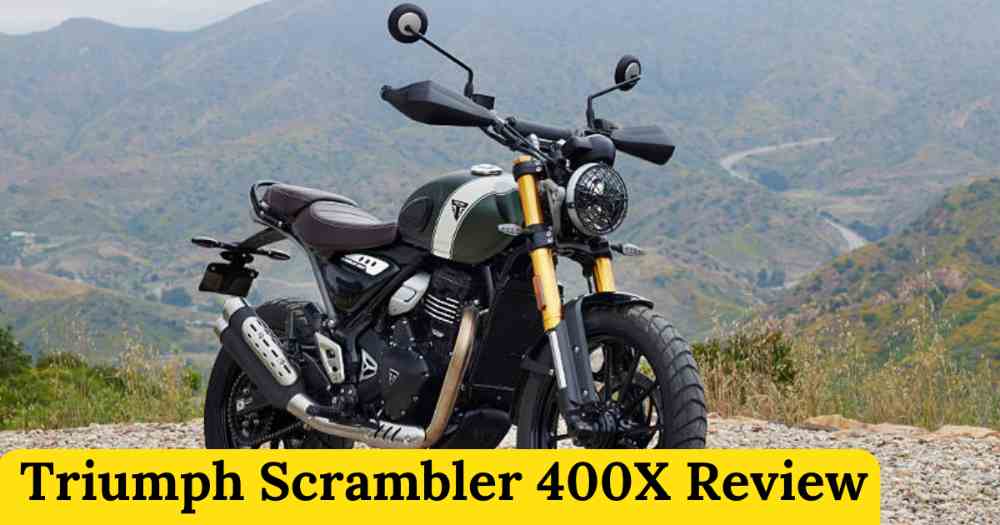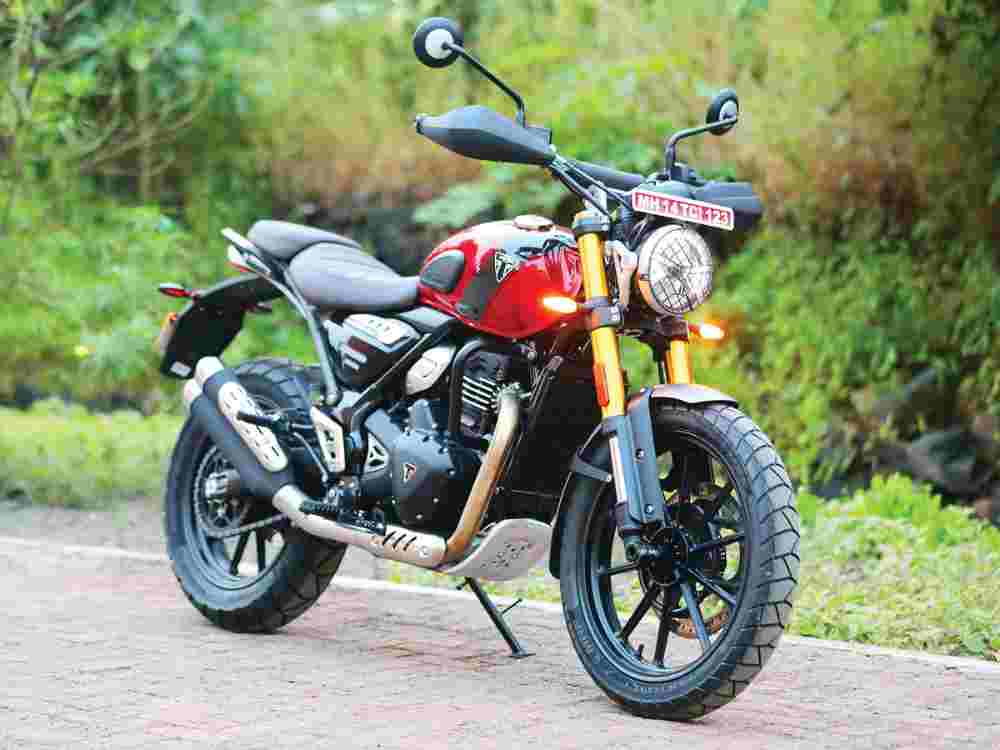Triumph Scrambler 400X Review: Best of Both Worlds
I recently had the chance to ride the Triumph Scrambler 400X through the scenic outskirts of Mumbai, and the experience was nothing short of incredible. The first ride left a lasting impression with its thrilling performance and smooth handling.

How was the Scrambler 400X born?
Before diving into the in-depth review of the Triumph Scrambler 400X, let’s take a quick look at how this motorcycle came to be. It all started over three years ago in 2020 when Bajaj and Triumph partnered with the goal of launching several mid-sized motorcycles (350-450cc), tailored for the Indian market. The first model from this collaboration was the Triumph Speed 400, a roadster that made its debut in July this year. Now, the spotlight shifts to the Scrambler 400X, which is gearing up for its release and is poised to captivate Indian riders.
Triumph Scrambler 400 X Video Review
What is a Scrambler, actually?
Scramblers have been present in the Indian market for quite some time, with brands like Jawa, Yezdi, Royal Enfield, and Ducati offering these models to enthusiasts. For those unfamiliar, Scrambler motorcycles are designed to provide the comfort of a touring bike during long rides, while also equipping riders with the capability to handle rough and uneven terrains, making them suitable for off-roading. In essence, these bikes are crafted to offer a balanced experience of both comfort and adventure.
However, some people and parts of the media are comparing the Scrambler 400X to the iconic Royal Enfield Himalayan, which is set for a major update soon. In my opinion, this comparison is somewhat misplaced. The Scrambler 400X is designed for all-road versatility, allowing for both long, comfortable journeys and light off-road excursions, while the Himalayan is an adventure-focused motorcycle, built primarily for more challenging off-road experiences.
Now, let’s address the question: Is the 400X truly a Scrambler, and how does it handle both on-road and off-road conditions? In our in-depth review, we’ll explore these aspects and provide answers to these key questions.
Read Also: Bajaj CT 110 with 72kmpl mileage
Triumph Scrambler 400X Ride and Handling
Though built on the same platform as the Speed 400, the Scrambler 400X stands out with several unique features. To start with, it weighs 185 kg, which is about 9 kg heavier than the Speed 400. This additional weight comes from a steel tubular handlebar, added metal in the frame, and a longer wheelbase. However, this increase in weight doesn’t compromise its agility or stability. In fact, when pushed to its limits, the Scrambler 400X feels remarkably light and responsive.
Triumph Scrambler 400X Seat Height and Ground Clearance

When it comes to the saddle height, this bike stands at 835 mm, which might pose challenges for shorter riders. Even though I’m 5’8″, I didn’t feel completely comfortable with both feet firmly on the ground while riding. In contrast, the Speed 400, with its lower seat height of 790 mm, caters better to shorter individuals. Additionally, the ground clearance of 195 mm adds to the difficulty for shorter riders, compared to the Speed 400’s more manageable 158 mm. For perspective, the Royal Enfield Himalayan has an even greater ground clearance of 220 mm, and rumors suggest that the upcoming model may have an even higher clearance. On the plus side, seat comfort is excellent, with its well-cushioned design ensuring a fatigue-free ride. The new, adjustable, wider handlebar also enhances the overall riding experience, offering an upright, easy grip that improves comfort and control.
How well do the suspensions work?
When it comes to the suspension system, the Triumph Scrambler 400X features 43mm upside-down (USD) forks with 150mm of wheel travel in the front and a rear monoshock unit that also offers pre-load adjustment with the same 150mm travel. In comparison, the Speed 400 maintains the same fork diameter but boasts enhanced wheel travel, increasing by 10mm in the front and 20mm in the rear. This improvement in suspension travel is specifically designed to enhance off-road capabilities. During my ride on a rough, stony road filled with potholes, the suspension performed exceptionally well, absorbing most of the impacts effortlessly. Its softer tuning contributes to improved balance and stability, making for a smoother ride.
What wheels are used in the Scrambler 400X?
Regarding the tyres, the Scrambler 400X is fitted with a 19-inch front and a 17-inch rear, providing excellent grip and performance on rocky terrain. In comparison to the Speed 400, the front wheel has been increased by 2 inches to enhance the bike’s rugged character and boost rider confidence during off-road adventures. While the rear tyre maintains the same size as the Speed 400, it is wider at 140/80-17, which is clearly designed to improve overall stability.
How effective is the braking system of Triumph Scrambler 400X?
Last but certainly not the least, Triumph Scrambler 400X is equipped with a 320mm fixed disc at the front and 230mm fixed disc at the rear. It won’t be an exaggeration to term it one of the best braking systems that I have experienced in modern day motorcycles. During the ride, I did sudden braking and was highly impressed by the braking distance, which is probably the shortest. Also, it never feels as if the motorcycle is losing stability and will eventually fall during instant braking, and the credit for that goes to the dual-channel ABS which is switchable. However, I couldn’t locate the switch from where one can turn it on and off despite trying multiple times through the LCD instrument panel.
Triumph Scrambler 400X Engine and Performance
The Scrambler 400X utilizes the same 398.15 cc single-cylinder, fuel-injected, liquid-cooled engine found in the Speed 400, delivering an identical output of 39.5 bhp and 37.5 Nm of torque. Notably, riders benefit from 80% of the torque available from 3000 rpm, resulting in an exhilarating performance. Its power-to-weight and torque-to-weight ratios are among the best in its class, further enhancing the bike’s overall capabilities. The motorcycle features a balanced 48:50 front-to-rear weight distribution, contributing to a smoother riding experience.

Paired with a 6-speed gearbox, which is also derived from the Speed 400, the longer gear ratios allow for effortless shifting. I was impressed by how quickly I could reach triple-digit speeds without even engaging the top gear. The 5th gear offers an especially long ratio, enabling riding at speeds as low as 30 km/h and accelerating to 120 km/h, which is advantageous for off-road conditions as it minimizes the need for constant gear changes. In terms of top speed, the Scrambler can comfortably reach around 145 km/h, although this may not be a primary concern for most buyers. Typically, vibrations are felt around the footpegs and handlebars at higher speeds, but during my ride, I experienced none, though I suspect they may appear beyond 150 km/h. Additionally, the slip and assist clutch is a valuable feature that works seamlessly with the gearbox.
What is the real-world mileage of Triumph Scrambler 400X?
According to Triumph, the Scrambler 400X offers a mileage of 28 kmpl, but during my short test ride, I was able to get around 25-26 kmpl. With its 13-litre fuel tank, you can enjoy a non-stop journey for close to 300 km before needing to refuel. One feature I haven’t highlighted yet is the upswept twin exhaust pipe, so let’s talk about it now! The roar it produces is unmatched, delivering that signature Triumph sound, loud and exhilarating, guaranteed to bring a smile to your face.
Triumph Scrambler 400X Design and Features
If the Speed 400 caught your attention, the Scrambler 400X is sure to leave an even bigger impression with its rugged design. This bike has a raw, adventurous vibe, sporting key Scrambler features like a black grille on the round headlamp, knuckle guards, an extended mudguard, a sump guard, and intricate logo detailing. The black powder-coated engine casings elevate its tough appearance even further. Personally, I find its design outstanding, outshining other bikes in the same category, though opinions may vary on that. When it comes to color options, the Scrambler 400X is available in three striking dual-tone combinations: Matt Khaki Green/Fusion White, Carnival Red/Phantom Black, and Phantom Black/Silver Ice. I had the chance to ride the red one, and it certainly turned heads.In terms of features, the Scrambler 400X borrows several elements from the Speed 400, including ride-by-wire throttle with switchable traction control, an analogue speedometer with a built-in LCD display, anti-theft immobilizer, full LED lighting with daytime running lights (DRL), a soft road mode, and a USB Type-C charging port. However, like the Speed 400, it lacks turn-by-turn navigation—a feature that Triumph may introduce in future models. Overall, the bike’s feature set is quite solid, and I doubt buyers will be left wanting.
Triumph Scrambler 400X Pros and Cons
Pros:
- Eye-catching design
- Exceptional performance
Cons:
- Limited to three color options
- Lacks navigation feature
Triumph Scrambler 400X Review – Verdict
The Scrambler 400X is priced at Rs 2.63 lakh (ex-showroom) in India and will be manufactured locally at Bajaj’s Chakan facility. Triumph has done a fantastic job with the pricing, and this could work in its favor, much like the Speed 400, which saw overwhelming bookings in a short time. One of the standout features of the Scrambler 400X is its impressive service interval of 16,000 km, offering convenience for riders by reducing frequent trips to the service center and enhancing the overall ownership experience. Additionally, buyers can choose from a wide range of Triumph accessories to customize the bike to their liking. With its top-tier ride quality, superb handling, excellent performance, and eye-catching design, the Scrambler 400X is well-positioned to make a lasting impression in the Indian market. If you’re looking for a stylish and versatile motorcycle, this is one to seriously consider. As I’ve highlighted in the title, this bike truly offers the ‘Best of Both Worlds,’ excelling both on-road and off-road.
Read Also:-
